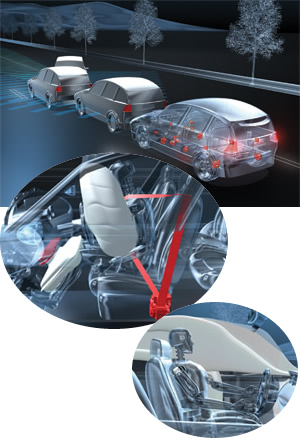
Adaptive Restraints – One of the prime examples of active and passive safety integration already available on vehicles is TRW’s active control retractor seat belt system. This system uses signals from active safety systems such as electronic stability control or brake assist to sense a possible loss of lateral vehicle control or an emergency stop situation. Once a potentially dangerous situation is sensed, the active control retractor seat belt rapidly removes slack to help better position the occupant for a possible accident. If the accident is avoided, the system will release after five seconds and return to normal seat belt mode.
Pre-Crash / Automatic Emergency Braking – The combination of forward-looking radar and video systems (adaptive cruise control and lane departure warning) provides an enhanced picture of the road ahead. When integrated with electronic stability control, these systems can enable automatic emergency braking to help mitigate the effects of impact. In addition to applying full brake pressure, the active control retractor seat belt can also be engaged prior to the actual impact, thus improving the margin of safety for the occupants.
Side Impact Integration – TRW active safety technologies such as electronic stability control or active dynamic control help drivers to avoid or mitigate the impact of vehicle accidents. Should an accident occur, passive safety systems will work in concert with active safety systems to better position occupants. In the event of a side impact collision,TRW’s curtain or side and thorax airbags inflate to offer a greater measure of protection.
|